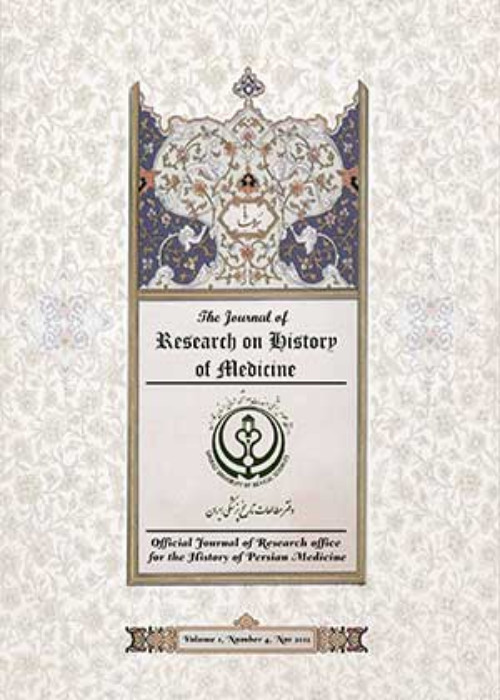فهرست مطالب
Journal of Research on History of Medicine
Volume:8 Issue: 1, Feb 2019
- تاریخ انتشار: 1398/02/04
- تعداد عناوین: 7
-
-
Pages 3-18During the reign of Salah al-din al-Ayyubi (Saladin), the founder of the Ayyubid state, the activities in the field of medicine and pharmacy have made considerable progress. Saladin gave great importance to the medical science and medical institutions and constructed the hospitals in important regions such as Egypt, Bilâd al-Sham and al-Jazirah, and these hospitals gradually became medical centers where theoretical and applied medical courses were processed. From these hospitals, the Bîmâristan al-Nûrî in Damascus and the Bîmâristân al-Nâsiri in Cairo continued to operate as two important medical centers, and Muslim, Christian and Jewish physicians came to these hospitals from various parts of the world and practiced medicine. Clinical medicine has emerged as the result of medical researches conducted in these hospitals. One of the most important developments in this period is the establishment of a madrasah by Rais al-Atibba Muhazzab al-Dîn al-Dakhwar, who only teaches medicine in the history of Islam. Famous physicians who have made great contributions to the medical science have lived during Saladin reign. Maimonides, Abd al-Latif al-Baghdadi, Muhazzab al-Dîn al-Dakhwar and Ibn Baytar are the leading figures of these pyhsicians. In the present article medical education in the reign of Saladin and the famous physicians of the period will be examined and developments in the field of medicine will be evaluated.Keywords: History of Medicine, Bîmâristân, Physician, Egypt, Syria, Saladin, Ayyubids
-
Pages 19-26Medical charlatanism is a significant topic in historical manuscripts from the golden age of Islamic medicine. The topic has been dealt with substantially in Adab al-Tabib, an epic work by AI-Ruhawi (12th century AD). In this paper, we review the challenges to medical charlatanism in Adab al-Tabib. AI-Ruhawi has offered a variety of strategies to fight against this phenomenon. We classified these strategies into prevention of and combating medical charlatanism. The formulation of a multifaceted assessment of candidates to medical training, respect for physicians and their rights, assessment of a medical practitioner’s competence and promotion of spiritual, ethical and religious values are considered preventive strategies. Strategies in the fight against charlatanism include monitoring a physician’s performance and exposure of charlatanism to the authorities. AI-Ruhawi has correctly understood the enormous risk posed by medical charlatanism and has provided practical and useful guidelines for its prevention and combating existing cases.Keywords: Adab al-Tabib, AI-Ruhawi, Medical charlatanism, Preventivestrategies, Strategies to combat
-
Pages 27-40Dr. John Martin Honigberger (1795-1869), a native of Romania was a very charismatic, energetic and devoted physician, scientist as well as traveller who spent more than thirty years of his life in the East. He was able to speak several languages fluently. He travelled to Turkey, Syria, Iraq, Central Asia and India etc. and devotedly practiced his profession there. He excelled in treating in various kinds of diseases through allopathic, homeopathic and other types of medical systems. He is the man who introduced homeopathy for the first time in India. During his journey, he suffered from critical diseases several times, but he remained safe and sound through his own treatment. Having latest knowledge regarding medical systems, he successfully treated various rare diseases and effectively performed many types of surgeries. During travelling he did not miss any opportunities to obtain information concerning medicine. He practiced in the regions of the Ottoman Empire and served as a royal physician in the Sikh Empire. A number of health centres, dispensaries and a gunpowder mill of the Sikh army were under his charge. His travelogue is certainly a remarkable account and every paragraph of it consists of significant lore.Keywords: Dr. J. M. Honigberger, Travelling, Medications, Lahore, Maharaja Ranjit Singh
-
Pages 41-56One of the most important urban issues is the health situation. Before the introduction of the modern medicine and health education in the cities, it should be mentioned that there were many infectious diseases due to the high rates of contamination especially for drinking water. During the reign of the first Pahlavi, efforts were made to improve the health of cities and modern medicine. However, many problems such as a lack of awareness and resistance of the people, failure of officials and carers to deal with medical affairs, paying too much attention to the center (Tehran) and neglecting the cities slowed the process of health change. In this article, six documents are analyzed that they are related to the Health Status Report in Shiraz in 1311 by the head of health of Fars that were written to the head of the state of Fars to be sent to the head of Iranian public health. The review of these documents provides useful and interesting information on the health status of Shiraz during that period.Keywords: Medical Records, Shiraz, Health Office, Hospitals, Pharmacies
-
Pages 57-64Surgical intervention was seen since mankind existed. The management of trauma was begun when first men suffered from wound complications in routine daily activity. The first Greek physicians combined magical and primitive medical methods to treat a wound. The study of surgery which was neglected after the Roman era was survived by Islamic scientists. They collected remaining ancient treatise and innovated new methods and instruments to manage a vast variety of diseases surgically. Surgical management of trauma is the main field of interest in papers written by scientists such as Rhazes, Al-Majusi, Albucasis and Avicenna. The aim of this study is to describe methods explained by Albucasis, as the greatest surgeon in golden Islamic era, to manage trauma patients with bleeding, airway obstruction, penetrating abdominal and arrow wound injuries.Keywords: Albucasis, Trauma, golden Islamic era


